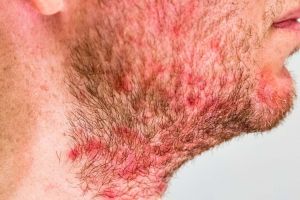Seborrheic Dermatitis
Seborrheic Dermatitis
Everything you need to know about
Seborrheic Dermatitis
The skin illness seborrheic dermatitis develops an itchy rash with flaky scales. On light skin, it causes redness, and on darker skin, it causes light patches. Dandruff, cradle cap, seborrhea, seborrheic eczema, and seborrheic psoriasis are all terms for the same thing.
It may resemble psoriasis, eczema, or an allergic reaction in appearance. It mainly affects the scalp, although it can affect any part of your body.
Symptoms
Cradle cap affects babies as young as three months old, causing crusty yellow or brown scales on their scalp. It normally goes away before kids are a year old, but it can return after they hit puberty.
Seborrheic dermatitis is often mistaken for diaper rash by parents.
Adults may develop seborrheic dermatitis on their faces, particularly around the nose, brows, eyelids, and behind the ears. It can also manifest itself in other sections of your body:
- In the middle part of your chest
- Around your navel
- On your buttocks
- In skin folds under your arms and on your legs
- In your groin
- Below your breasts
Itchy or burning skin is possible. The flaking scales may be white or yellowish in colour and appear wet or oily.
Because seborrheic dermatitis might resemble other skin disorders, you should consult your doctor for a diagnosis and treatment plan.
Seborrheic Dermatitis Diagnosis
Your doctor will examine your skin and ask about your medical history. They may scrape a small piece of skin and examine it under a microscope to rule out skin disorders such as:
- Psoriasis. A lot of silvery-white scales appear on your elbows and knees as a result of this. It can also alter the appearance of your fingernails. It’s possible that you have both this and seborrheic dermatitis.
- Eczema (atopic dermatitis). Inflammation of the skin on the head, elbows, and knees is common.
- Rosacea. This can also occur in the presence of dermatitis. It develops a red rash on your face with few or no scales. Rosacea might disappear and reappear multiple times.
- Allergic reaction. If your rash is itchy and doesn’t go away after therapy, it could be due to an allergy.
- Systemic lupus erythematosus (SLE). This illness can develop a butterfly-shaped rash over the middle of your face in its early stages.
Causes
The specific cause of seborrheic dermatitis is unknown. It appears to be a combination of factors, including:
- Stress
- Your ancestors
- A yeast that resides on your skin without creating problems most of the time.
- Certain medical problems and medications
- Weather: cold and dry
- A reaction of the immune system
- It isn’t caused by an allergy or a lack of cleanliness.
When to call a doctor
You’ll probably start by seeing your primary care physician. He or she may recommend you to a dermatologist if you have a skin problem (dermatologist).
Here’s some information to help you prepare for your consultation.
What to expect from your doctor
Your doctor will most likely ask you several questions. Being prepared to respond to them may allow you to devote more time to any points on which you wish to elaborate. Your doctor might inquire:
- What are your symptoms, and when did you notice them for the first time?
- Are these symptoms new to you, or have you experienced them before?
- What is the severity of your symptoms? Is it the same all the time, becoming worse, or is it better and worse at different times?
- Have you tried any home remedies like lotions, gels, or shampoos?
- How frequently do you use these remedies?
- Is there anything that seems to help?
- Is there anything that seems to aggravate your symptoms?
- Are you using any drugs, vitamins, or supplements?
- Have you recently been stressed or gone through major life changes?
Treatment
Seborrheic dermatitis can sometimes go away on its own. However, it is frequently a lifelong problem that clears and flares. It’s usually manageable with proper skincare.
Discuss a treatment strategy with your doctor. They’ll most likely advise you to start with over-the-counter and home remedies.
If you have seborrheic dermatitis on your scalp, look for a dandruff shampoo that has one of the following ingredients:
- Coal tar
- Ketoconazole
- Salicylic acid
- Selenium sulfide
- Zinc pyrithione
If your infant has cradle cap, wash their scalp with warm water and baby shampoo on a daily basis. A dandruff shampoo could irritate their skin, so consult your paediatrician before using one. To soften thick spots, apply mineral oil to the region and gently brush away the scales with baby brushes.
Keep the affected parts of your face and body clean if you have seborrheic dermatitis. Every day, wash with soap and water.
Being outside may help the rash go away by slowing the growth of the yeast organisms that are causing the problem. Always remember to apply sunscreen.
Treatment options include:
- Antifungal medications
- Lotions containing corticosteroids
- Products containing sulphur
These medications may have negative effects, especially if taken for an extended period of time. Follow your doctor’s instructions. A combination of treatments frequently yields the best outcomes.
If your seborrheic dermatitis doesn’t improve, the area gets painful, red, or swollen, or it starts to drain pus, see your doctor. To alleviate the symptoms, they may prescribe a prescription ointment, shampoo, or antifungal medications.
Seborrheic Dermatitis Risk Factors
Seborrheic dermatitis is more common in newborns and adults aged 30 to 60. It’s more frequent in men than in women, and it’s more common in persons who have oily skin. Adults are also at risk from these conditions:
- Acne
- AIDS
- Alcoholism
- Depression
- Eating disorders
- Epilepsy
- Heart attack or stroke recovery
- Parkinson’s disease
- Psoriasis
- Rosacea


